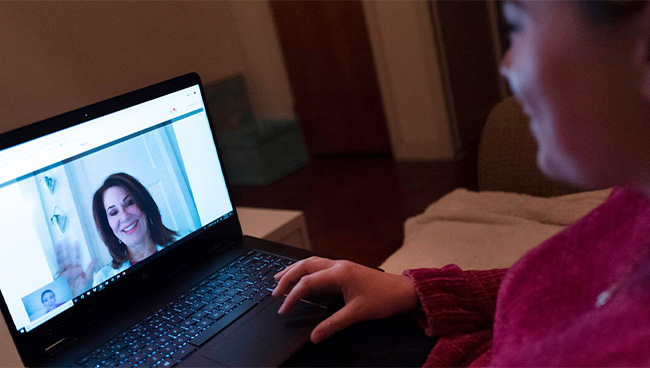BY JACOB BOGAGE // The Washington Post, March 28, 2020
With the rise of video conferences, workers realize they need professional tops, but not bottoms.
A few more shelves might be looking bare at Walmarts around the country, or at least a few more bins empty at fulfillment warehouses. Customers are making a run on tops: shirts, blouses, button-downs, polos, you name it.
As more people work from home during the coronavirus crisis and video conference becomes businesses’ new lifeblood, pants are suddenly less important. When all a webcam captures is a user’s head and torso, employees are buying more shirts, according to Walmart, and not slacks.
“Talking about people [using] Zoom, and doing those types of conferencing, we’re seeing increased sales in tops, but not bottoms,” Dan Bartlett, Walmart’s executive vice president of corporate affairs, told Yahoo Finance on Thursday. “People . . . are concerned, obviously, from the waist up. These behaviors are going to continue to change and evolve as people get accustomed to this new lifestyle.”
The company did not respond to a request for comment or more exact sales figures.
“It’s come to a level of, what is important? What shows credibility? Does it require a suit and tie? People realize they don’t have to wear a suit and tie because they know changing the world doesn’t require wearing a suit and tie.” –Wendy Liebmann
Shoppers tend to buy more tops than bottoms, anyway, for obvious practical reasons. Who really needs that many pairs of pants? Or skirts? You can rewear clean bottom pieces; tops, not so much. And retailers have seen a surge in top sales for a while now, thanks to the Instagram nature of fashion, said Wendy Liebmann, chief executive and chief shopper at WSL Strategic Retail. In the conventional selfie angle that shows off a new blouse or button-down, pants are hardly ever in the picture.
But the tops’ resurgence has a lot to do with the notion that workers are trying to maintain a sense of professionalism while clocking in remotely. In-office fashion has grown increasingly causal over the years, so much so that even the athleisure fad that has gripped the clothing industry has seeped into the workplace, Liebmann said. Leggings as pants? Sure! Hoodies instead of cardigans? Fine! Sneakers rather than dress shoes? Whatever!
But when workers are thrust into a work-from-home environment, they can sometimes feel internal and external pressure to boost productivity, or at least feel that they’re maintaining a sense of office decorum, said fashion psychologist Dawnn Karen, author of the book “Dress Your Best Life.”
“If you’re not able to wear your outfit that you wear to work, you feel less productive,” she said. “You feel useless. That affects your self-esteem.”
So when workers hop on a video chat with colleagues, they often grab a professional-looking top, even if they’re still wearing pajamas or sweatpants out of view. And instead of rifling through drawers or closets to find yet another half-outfit for a day of tele-meetings, some end up buying more outfits online, too.
That’s where the sales bump is coming from, Karen said. At its core, it’s the result of people desperate to display to others that they’re working hard, and to find comfort and control in a new routine that could last an indefinite period of time.
Expect that to peter out in the coming weeks and months, however long society stays bottled up to slow the spread of the coronavirus, Liebmann said. Folks are going to get acclimated enough to working remotely that they won’t pay as much attention to what their wardrobe signifies.
“It’s come to a level of, what is important? What shows credibility? Does it require a suit and tie?” Liebmann said. “People realize they don’t have to wear a suit and tie because they know changing the world doesn’t require wearing a suit and tie.”
Sure, once society can finally venture out again, workers might spend a month more well-attired than usual, she added, just for a change of pace. But like so many discoveries about the nimble nature of office work, the corporate world is on the verge of another: It matters even less what people wear to get the job done.
“We’ve had this causal trend for a while,” Liebmann said. “We had corporate causal Fridays for a while, and then the whole workforce became more causal every day. As people work from home more after this, when we come out of this, we’re going to be focused on things that are foundationally important to us. That’s comfort, ease and feeling good about yourself.”
Article source here.


